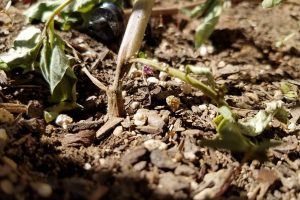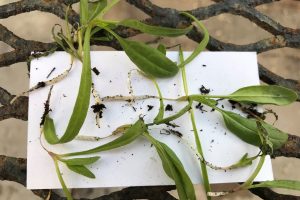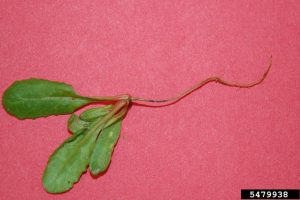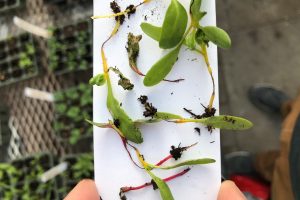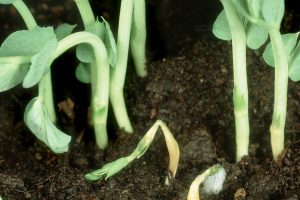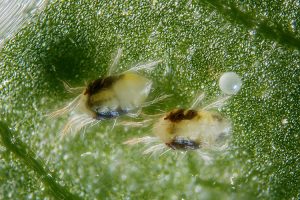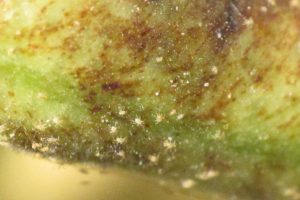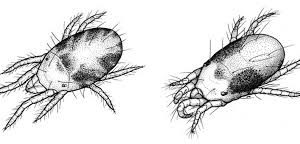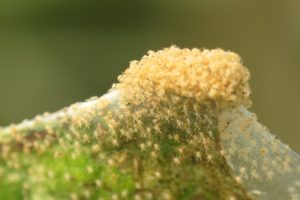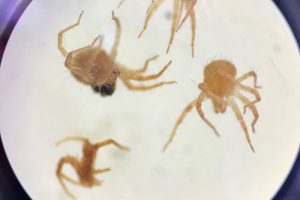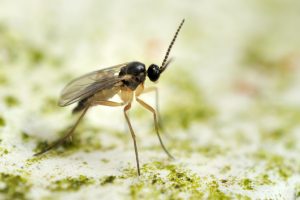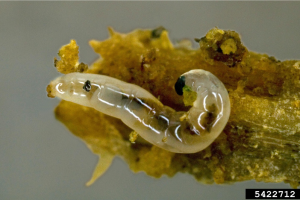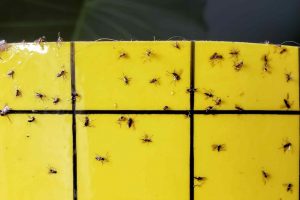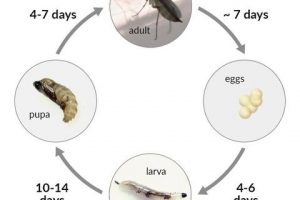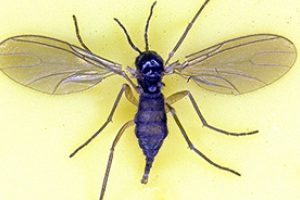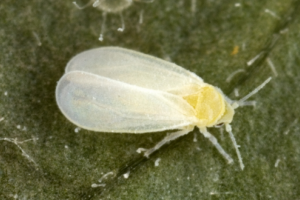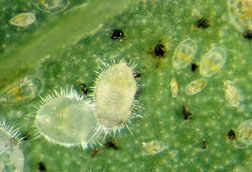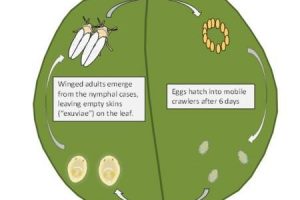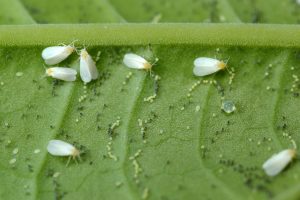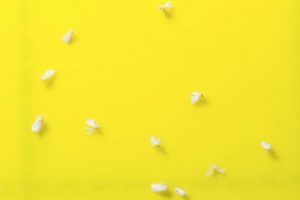Damping Off
Occurrence: Very common in greenhouse transplant production and other interior seed starting
Description: Damping-off is caused by several soil-borne fungi including Pythium, Rhizoctonia, Fusarium, and Phytopthora species. This disease notably kills newly germinated seedlings. Infections cause the lower stem to turn brown/black and fall over. The fungi can be found in small amounts of soil on benches or reused growing containers. Once the seed is planted and watered, fungal spores will start to colonize the soil in that tray (Damping-Off Fact Sheet).
Management:
- Sterilize greenhouse surfaces along with growing containers with disinfectant products. Examples of effective products include those with active ingredients such as quaternary ammonium compounds, hydrogen dioxide, hydrogen peroxide + peroxyacetic acid, and chlorine bleach. Always review product labels for instructed use.
- If the disease is present, remove infected plants and soil. Closely monitor nearby seedlings for infection spread. Always source a sterile potting mix.
- Avoid excessive irrigation, as standing water can allow for disease spread.
- Purchase treated seeds with fungicides such a thiram.
Spider-Mites
Occurrence: Very common in greenhouses
Description: Multiple species of spider mites can be inside greenhouses. They require a hand lens (20x) to see and mostly feed on the undersides of leaves. They are oval-shaped and cream-colored. The body contains two large, dark, visible spots that are an accumulation of body wastes. Young mites may lack the spots. Populations increase rapidly in hot, dry conditions. Mites feed by piercing leaf cell walls with their mouthparts and sucking out the contents of the cell, causing them to become non-functional. Leaves become stippled, and with heavy feeding, will appear chlorotic overall with some dieback. Plant growth will decline.
Management:
- Monitor for spider mites by visually scouting for webbing on plants.
- There are several conventional and organic pesticides (miticides) labeled for mite control. They include active ingredients such as pyrethrins, insecticidal soaps, plant-based oils, abamectin, etoxazole, chlorfenapyr, and spiromesifen. (Avoid over an application as mites may develop resistance and beneficial predators may be affected). Always review product labels for instructed use.
- Some natural predators can be purchased and released into greenhouses for biocontrol. These species include the predatory mites Amblyseius andersoni, Galendromus occidentalis, Neoseiulus californicus, Neoseiulus fallacis, Phtoseiulus persimilis, predatory gall midge Feltiella acarisuga, and the spider mite destroyer Stethorus punctillum. (Reference the Utah Greenhouse Biocontrol Guide)
Fungal Gnats
Occurrence: Very common in greenhouses, indoor seeding starting, house plants, etc.
Description: These are small (3 mm) flies that resemble mosquitoes. They have characteristic long legs, long antennae, and a Y-shaped vein on the tip of the wing. They fly in short, darting movements. Females lay up to 200 eggs in the soil of potted plants. Larvae live for up to 20 days, feeding on plant root hairs in the top few inches of the soil. They pupate near the soil surface. Wilting and reduced vigor due to root loss. Young seedlings and plugs are especially vulnerable. Adults do not feed on plants, but can be a nuisance.
Management:
- Monitor fungus gnat populations by using yellow sticky traps.
- Ensure potting medium is sterile (pasteurized) and free of mold growth.
- Prevent standing water in the greenhouse as this may allow algae growth, which is attractive to fungus gnats.
- Some natural predators can be purchased and released into greenhouses for biocontrol. These species include the predatory rove beetle Dalotia coriaria, soil-dwelling predatory mite Stratiolaelaps scimitus, and the beneficial nematode Steinernema feltiae. (Reference the Utah Greenhouse Biocontrol Guide)
Whiteflies
Occurrence: Very common in greenhouses
Description: The two most common species are the greenhouse whitefly and the silver leaf whitefly. Females lay up to 250 oblong eggs on the undersides of leaves. Nymphs resemble scale crawlers in that they are immobile, flat, and translucent. Whiteflies use their piercing, straw-like mouthparts to suck sap from phloem on plant stems and leaves. Large populations can cause leaves to turn yellow, appear dry, or drop. Feeding can cause plant distortion or discoloration. Whiteflies excrete honeydew, causing leaves to be sticky or covered with black, sooty mold that grows on the honeydew.
Management:
- There are several conventional and organic pesticides are labeled for whitefly control. They include active ingredients such as horticultural oils, pyrethrums, pyrenthrin, azadirachtin, bifenthrin, cyfluthrin, and acephate. Always review product labels for instructed use.
- Monitor whitefly populations by using yellow sticky traps.
- Inspect plant material for whitefly infestations before bringing new plants into a greenhouse. If necessary, allow a period of quarantine.
- Use screens for greenhouse openings such as doors, vents, and windows. This will exclude whiteflies from coming from the outside environment.
- Remove plant residues and weeds from the greenhouse. They can serve as alternate hosts for whiteflies.
- Some natural predators can be purchased and released into greenhouses for biocontrol. These species include the predatory mite Amblyseius swirskii, predatory beetle Delphastus catalinae, and parasitic wasps Encarsia formosa and Eretmocerus eremicus. (Reference the Utah Greenhouse Biocontrol Guide)
- Consider allowing a “crop-free period” inside the greenhouse to “break” the life cycle of whiteflies by removing their food sources.

